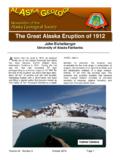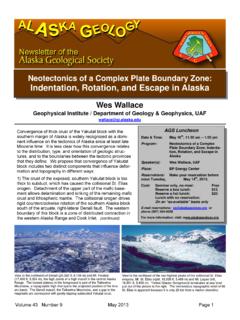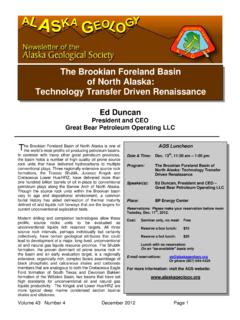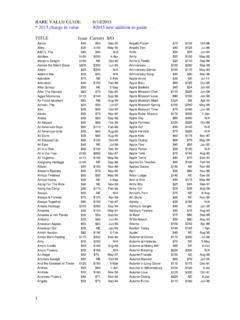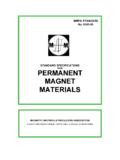Transcription of Rare Earth Element (REE) Deposits Associated with the ...
1 Volume 42 Number 5 January 2012 Page 1 AGS Luncheon Date & Time: Jan. 19th, 11:30 am 1:00 pm Program: Rare Earth Element Deposits Bokan Mountain, SE Alaska Speaker(s): Susan M. Karl, Geol. Survey Place: BP Energy Center Reservations: Please make your reservation before noon Tuesday, Jan. 17th, 2012. Cost: Seminar only, no meal: Free Reserve a box lunch: $15 Reserve a hot lunch: $20 Lunch with no reservation: On an as-available basis only E-mail reservations: Or phone (907) 644-4429 For more information: visit the AGS website: Susan M. Karl1, Jaroslav Dostal2, and James C Barker3 Geological Survey, 4210 University Dr., Anchorage, AK 99508, 2 Department of Geology, St.
2 Marys University, Halifax, NS B3H 3C3, Canada 3 Ucore Rare Metals, Inc., PM Box 145, 3875 Geist Rd. Suite E, Fairbanks, AK 99 The Bokan Mountain granite complex in southernmost southeast Alaska hosts structurally controlled U, Th, and rare Earth Element (REE) Deposits , including the Ross Adams mine, from which about 77,000 metric tons of high grade uranium ore was produced between 1957 and 1971. In map view the Bokan Mountain granite pluton is a little more than 3 km in diameter, composed mainly of medium-grained peralkaline granite that is seriate to porphyritic and contains aegirine and arfvedsonite. Andalusite in hornfelsed pelite, biotite-apatite pairs in host Ordovician granodiorite, and fluid inclusion data from the Bokan granite indicate epithermal emplacement of the pluton and dikes.
3 The Ross Adams uranium deposit consists of a brecciated, mineralized shear zone 7-10 m in diameter that cuts across the pluton margin and extends about 300 m along a northerly trend that contains NW-striking en echelon lenses with strike lengths in excess of 30 m and widths of 3 m; these faults and tensional features indicate a sinistral sense of shear. Hematitic alteration on fractures that cut the ore veins, and quartz veins above and parallel to these ore veins that contain fluorite, aegirine, and sulfides, are attributed to deposition from late hydrothermal fluids. Elsewhere, mineralized pegmatites and felsic vein-dike systems intrude the Bokan Mountain granite and extend along steep structures for more than 6 km NW and SE from the stock.
4 Pegmatites range up to 10 m in width; dikes are finer grained at greater distances from the stock. The dikes are typically less than a meter wide; the largest dike system is the Dotson trend, which consists of sets of steep, subparallel 2-mm- to 70-cm-wide dikes in a zone 50 m wide. Dikes have chilled margins, but commonly have wavy irregular contacts with wispy apophyses and anastomozing networks of crosscutting veins. The dikes commonly have pegmatitic quartz-albite cores and dark aphanitic selvages composed of iron-REE oxides (FeREO). Many dikes contain internal parallel felsic dikes that have chilled margins and REO selvages, indicating multiple, Rare Earth Element (REE) Deposits Associated with the Lower Jurassic Peralkaline Granite at Bokan Mountain Southeast Alaska Volume 42 Number 5 January 2012 Page 2 discrete episodes of dike intrusion along active structures.
5 The Geiger dike contains en echelon quartz-filled tension gashes and cm-scale offsets of internal veins that indicate a sinistral sense of shear. Late pyrite veins and mineralized quartz veins fill shear zones that cut the pegmatites and dikes and are consistent with sinistral kinematics. Some Dotson dikes show similar fabrics. One cm-scale sinistral offset of a pegmatite at the I & L prospect is coated with dark FeREO mineralization attributed to late hydrothermal fluids. The granite, pegmatites, dikes, and quartz veins are commonly cut by late, steep, EW- and NW-SE-trending structures that range from discrete faults to shear zones tens of meters across. Pervasive protoclastic textures in the granite are reflected in cracked feldspars and strained quartz.
6 Pinch-and-swell pegmatites within the grantie stock are also pervasively brecciated. In some cases the shear zones are mineralized with hematitic REO coatings that permeate along grain contacts for several meters into the granite, dikes, and country rocks. At the Wennie prospect, black FeREO mineralization enriched in heavy REE (HREE) permeates granite up to 5 m adjacent to shear zones. Several shear zones at the Wennie site have sinistral fabrics, and one shear zone is offset 3 cm by a mineralized normal fault. In calcareous argillite and marble near the southern contact of the pluton, meter-scale sinistral shear zones host fluorite-REO mineralization at the Piper Purple prospect.
7 Throughout the Bokan Mountain complex, late hydrothermal and metasomatic mineralization show enrichment of HREE relative to REE mineralization in the earlier pegmatites and dikes; we infer remobilization and concentration of REE during successive injection events in an active tectonic environment. Fabric analysis of host rocks indicates the lack of a Fig. 1. Bokan Mountain, view from the southeast, on the road to the I&L prospect Fig. 2. Bokan Mountain Area Geologic Map Map Credit: Thompson, , Pierson, , and Lyttle, T., 1982, Petrology and petrogenesis of the Bokan Granite Complex, southeastern Alaska: Geol. Soc. Of Amer. Bull., v. 93, p. 898-908. Volume 42 Number 5 January 2012 Page 3 dominant NW-trending regional fabric prior to intrusion of the Bokan Mountain granite.
8 Repeated magmatic and hydrothermal injections and displacement of earlier injections within dikes that occupy steep km-scale structures indicate the structures remained active during intrusion and cooling of the complex. Late Jurassic and Early Cretaceous lamprophyre dikes cut the late shear fabrics in the Bokan Mountain pluton and mineralized dike complex. The host rocks to the Bokan peralkaline granite complex are Ordovician monzonites and diorites that intrude metavolcanic and metasedimentary rocks of the Neoproterozoic Wales Group and Ordovician Moira Group, which have been shown to represent an oceanic arc in the Alexander terrane. Geochemical analyses show that Bokan Mountain granites and dikes have high concentrations of K, Na, and incompatible elements , low Al contents, and high Rb/Sr ratios.
9 REE normalized to chondrite show flat to slightly LREE and HREE enriched (V-shaped) patterns, with a large negative Eu anomaly. Trace Element ratios classify the Bokan Mountain granite as an A-type, anorogenic granite. Elevated contents of incompatible elements and high positive Nd values support a depleted upper mantle source for the granite, unaffected by contamination from continental crust or the Neoproterozoic-Ordovician arc complex. The geochemical and isotopic signatures are consistent with an extensional tectonic setting. A new U-Pb zircon age for the Bokan Mountain granite of 177 Ma has few counterparts in the Alexander terrane, limited to the REO-bearing Dora Bay pluton located 25 km NW of Bokan Mountain, and rhyolites of the bimodal Moffat Volcanics, 100 km to the SE of Bokan Mountain in British Columbia.
10 There was no arc activity in the Alexander terrane in the Early or Middle Jurassic. The late Early Jurassic alkaline igneous rocks are located along the southern margin of the Alexander terrane in southeast Alaska, transverse to the orientation of both the Late Triassic arc and the Late Jurassic-Cretaceous arc, which extend for more than 1000 km along the length of the terrane. Paleomagnetic analyses place the Alexander terrane approximately 19 north of the Equator in the Late Triassic and indicate 138 degrees of clockwise rotation. The Dora Bay, Bokan Mountain, and Moffat Island igneous complexes may represent extensional jogs along Early Jurassic sinistral-oblique translational structures within the Alexander terrane that were active during rotation and northward migration of the terrane.

